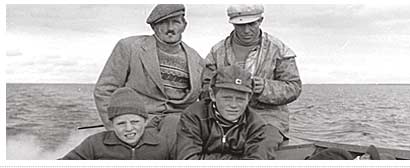|
|
The games of the Inari Sámis were based on nature and the materials at hand. Because of the sparseness of population, party games that required several participants were fewer than where the population was denser. The closest neighbors could be five or ten kilometers away. There were exterior influences on the games played and, especially later, universal games were learned in school.
Living amidst nature made a variety of games possible. Climbing, sliding, running, jumping, hiding, snowball fights, snow and play hut-making were natural and easily accomplished.
The lives of adults were the models for some games and at the same time this trained the children for their living conditions. This included such games as lasso throwing, bow shooting and even harnessing lemmings for driving. Small fish were caught from the shore, gutted and salted with sand.
A good lasso thrower was appreciated in the grownups’ world. Children also threw lassos, sometimes at antlers, sometimes at each other. One lasso game was when the player went on skis without poles until he came to a spot where he threw the lasso at a stump or a fence post and pulled himself towards it, loosened the lasso and looked for the next target. The route had to be chosen so that the player would not wind up in a dead end.
Boys have always thrown stones. Sometimes it was sharpshooting or competitions to see who could throw farther. With a sling one could throw a stone yet further. The sling was just a stick that was split at one end. A stone was placed in the split end and then jettisoned as it was slung.
Inari Sámis did wrestling but no other adversarial games. The kind of wresting they did was not the Greek-Roman type, rather waste-lock wrestling.
Tirppa is a game in which the game implement is a baton made of wood, which is hit with a stick to get it to a particular target.
Sorjompäddi is a swing using a single line, or a strap, attached to the branch of a tree.
Party Games
T. I. Itkonen writes about various throwing games. One is Little Bird. One person throws a ball at the others. Whoever it hits pretends to be dead. In this game one could also shoot (by blowing) a small stone or saxifrage bead at others. The hunter stalks the prey, but if the bird notices the stalker it can “fly away” and no one is allowed to shoot it.
Another game is Turnip Toss. In this, two people sit on opposite sides of a pot on the stove who throw turnips at each other. When the turnips collide, they fall into the pot. The cooked turnips are taken by one person and tossed up into the air. Whoever is hit by the turnip gets to eat it.
In wolf and reindeer games, one is a wolf and the others are reindeer. In the past, the parents would not allow this game, because it foretold the coming of a wolf.
Little Hawk was done by having one child in the middle of a room and the others around him. The hawk would try to catch someone. If it succeeded, the prey had to become the hawk’s helper in catching others. It was possible to also agree on a safe haven.
Toys
Reindeer antlers were easily obtainable. These could be held by straps and moved and driven like reindeer. The knee bone from the back leg of a reindeer, or kuálppihâš was a toy reindeer, but it could also be a sled. The hoof bones of reindeer were people. Toy reindeer could also be small stones, cones or pieces of bark. Bark and cone reindeer could have stick legs. Wooden sticks could be made into reindeer by carving shavings for antlers. Birch bark was cut to make standing reindeer.
Toys could be made from bird chest bones or piksâ and two-pronged bones made antlers, which could be cows or reindeer.
Various kinds of dolls were made from wood and leather. Swimming contests could be arranged for wooden figures.
The shoulder bone of a hawk was thrown onto the floor, saying: Ruŋk-runk, káránâs. Kost kulij kyessi puátá? (Caw-caw, raven. Which way is the visitor coming from?) Wherever the beak-end of the bone points is the direction of the visitor.
A rattle was made by blowing up the crop of a bird full of air. The crop became like a balloon and twigs or pieces of pine or spruce inside were shaken.
Matti Morottaja
|
|
| Doll-maker Nili-Aili’s, Aili Mattus’ dolls from the last half of the century. |
|
| Students at recess at school in Nellim. |
|
|


![]()

